La Rana
Project Snapshot
La Rana is a single-player exploration-based puzzle game. In the game, the player must help the last remaining guardian spirit of an ancient temple return rain to the world. La Rana is the perfect game for casual players who enjoy exploration and light puzzle-solving mechanics.
Engine: Unreal Engine 4
Team Size: 14 people
Development Time: 200 hours
Game Synopsis
La Rana is a single-player puzzle platformer set in a mysterious Mayan-inspired water temple. Players play as the last guardian spirit of the temple, who takes the shape of a small frog. The frog spirit is imbued with magical powers that allow him to use water to move geometry around the temple. These abilities help him solve ancient puzzles and journey around the temple in search of the other guardian frog spirits, who have been turned to stone by a curse.
As the player journeys through the temple, they begin to see the effects of the curse placed on it more clearly. All the water that once flowed through it has been turned to poison by the ancient snake goddess that turned all the temple's spirits into stone. The player must use their ability to manipulate geometry and mechanisms in the temple to avoid the poison and search out the other spirits hidden around the temple.
La Rana's stunning visuals, vibrant soundtrack, lifelike environments, and approachable gameplay make it the perfect game for young or casual players looking for a simple, enjoyable experience.
Roles and Responsibilities
The 14-person team for La Rana was comprised of five level designers including one lead level designer, four artists including one lead artist, three programmers including one lead programmer, one game designer, and one producer.
My Title: Sound Designer/Level Designer
My Team Size: 1 (Sound), 4 (Level Design)
Responsibilities: Sound Designer
Responsibilities: Level Designer
- Create or find all sound assets for La Rana including gameplay sounds, environmental sounds, UI sounds, and music
- Balance sound across the game and in the menus
- Collaborate with artists and game designer for feedback regarding sound effects and sound balance
- Collaborate with programmers to design Blueprints to help with sound implementation.
- Collaborate with lead level designer to make sure that gameplay sounds fit with existing gameplay
- Take feedback from leads, game designer, and stakeholders regarding sound and respond appropriately
- Create distinctive acoustic moods and environments using effects like reverb and randomization of environmental sounds.
- Design puzzles and environments that fit the game vision as communicated by the lead level designer and game designer
- Iterate on level/puzzle design in response to lead, game designer, and stakeholder feedback
- Work collaboratively with other level designers to create a cohesive player experience between levels
- Test gameplay and iterate based on feedback
- Implement gameplay and aesthetics to create polished-looking levels

Work Samples
Lilypad Tutorial Room
This room fits into La Rana's second level. It tutorializes one of the game's core mechanics, teaching the player that they can use lily pads to cross large swaths of poisoned water. The lilypad tutorial room incorporates old mechanics with new ones to help players learn about the lilypad mechanic while surrounded by familiar aspects of gameplay like moving blocks and hidden collectibles.
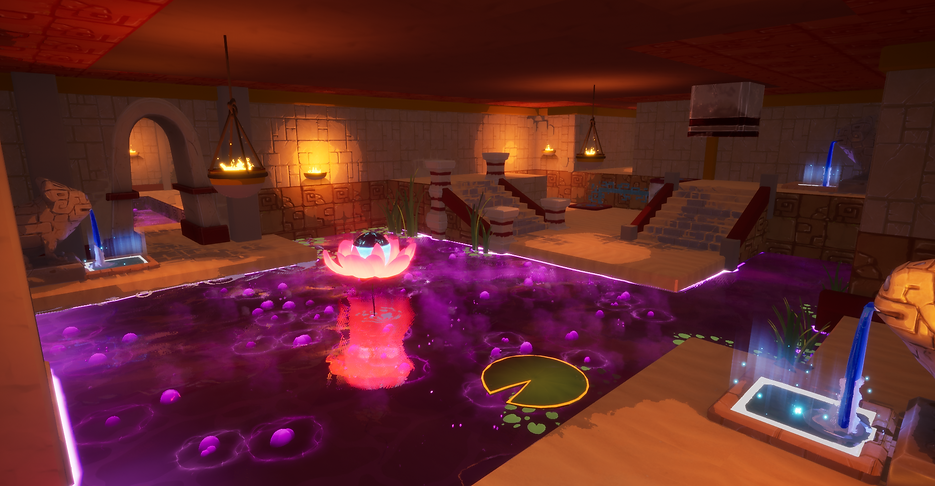
Lily pad tutorial room overview

When considering how to tutorialize the lily pad mechanic, I took La Rana's pillars, its core loop, and its overarching vision into account. La Rana is meant to be a casual and rewarding experience, and I wanted my tutorial to feel the same way.
I created a space that allows the player to explore but also offers gentle nudges to get them started. For instance, when they first enter the tutorial room the lily pad is right in front of them, along with a station to refill their water. Playtesting showed that many players were instantly drawn to the lily pad because of its placement.
The player's view on entering the lily pad tutorial room
To immediately let players know they did something right by jumping onto the lily pad and squirting the flower it is connected to to make it turn, I placed a collectible at the first "stop" the lily pad makes.
This immediate connection between causing the lily pad to turn and collecting a reward let players know that they made the right choice by activating the lily pad.

A hidden collectible near the lily pad's rotating path

Each time the player spins the lily pad they are afforded access to a new part of the room. In this section of the lily pad tutorial room, I wanted to reinforce some of the mechanics players had already seen to help them understand how the lily pad mechanic fit into the larger context of the game.
This section of the room contains dynamic geometry we called "paired blocks". These are pieces of geometry players can activate to help them access new parts of the level or reveal secrets, like the hidden collectible in this image.
Paired blocks and a hidden collectible in the lily pad tutorial room
Grand Staircase
In collaboration with artists and other level designers, I helped create this grand staircase that affords players an impressive view of the temple they are exploring. The idea was inspired by the Mayan and Babylonian architecture our team was striving to replicate in La Rana.
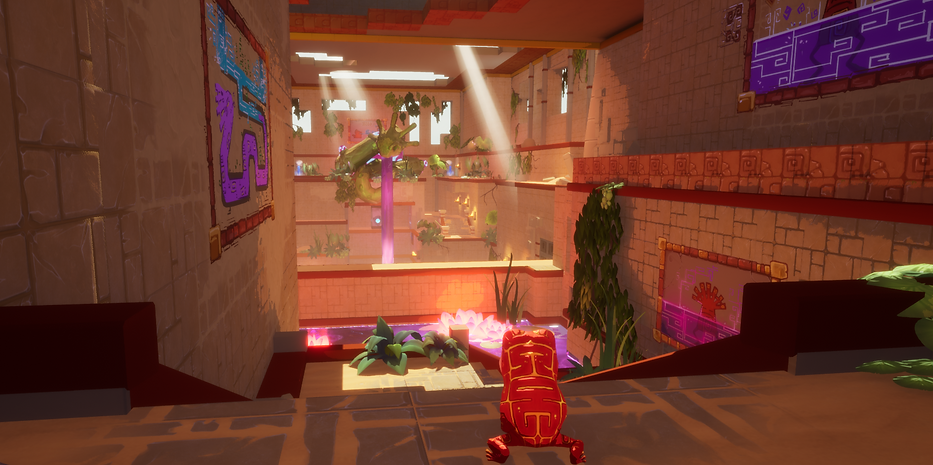
The grand staircase from the player's perspective
The grand staircase allowed me the opportunity to create a vibrant acoustic environment. The player enters the grand staircase after having been in a small, cramped chamber. When they emerge, they are greeted by birdsong, the calls of insects, and soft, soothing music.
Our team worked hard to make the grand staircase a "wow moment" for the player. The acoustic environment played a large part in fulfilling that goal.
Please see the video for footage of the grand staircase and its acoustic environment.
Rain Particles
The player's goal in La Rana is to reach the center of the temple and bring rain back to the world. I created a particle system using Unreal's Cascade editor that emulated realistic rain. I experimented with effects like refraction, reflection, and opacity to create a particle system that would look believable in the cel shaded lighting and graphics style my team's artists opted for.

Rain falling during La Rana's final cutscene
I was responsible for creating the rain particles using the Cascade editor. This was my first experience with particles in Unreal. I utilized several different particle emitters to create a threefold effect: Rain falls, fog is generated where it lands, and small "offshoot" particles rise from the ground where some of the raindrops fall.
By incorporating multiple emitters and particles, I was able to create a realistic effect that fit into La Rana's graphical style and looked polished.
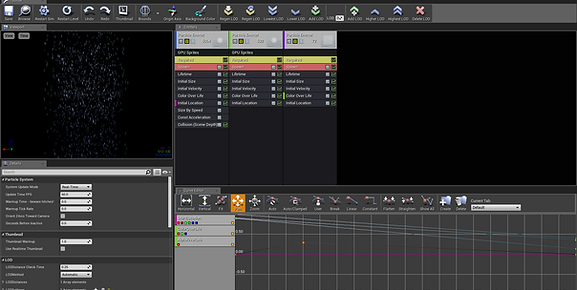
The architecture for the rain particles in Cascade

Blueprint to control components of the rain effect
I was responsible for Blueprinting functionality for the rain effect. I created several custom functions and events to control different aspects of the rain effect. A thunder sound, the particle system itself, and a post processing volume that made the sky look stormy all had to be controlled by event input.
I created this Blueprint and the functionality to enable and disable the rain on trigger. After this was done, I worked collaboratively with the programmers to make sure my effect could be triggered when necessary during gameplay.
Dynamic Environmental Sounds and Background Music
In addition to finding/creating and balancing the sounds in La Rana, I was also responsible for creating systems that added variance and interest to the game's soundscapes. Each level had unique music to help enhance their atmospheres, and sounds like insect chirps and bird calls were randomized to add realism and variety to the gameplay.
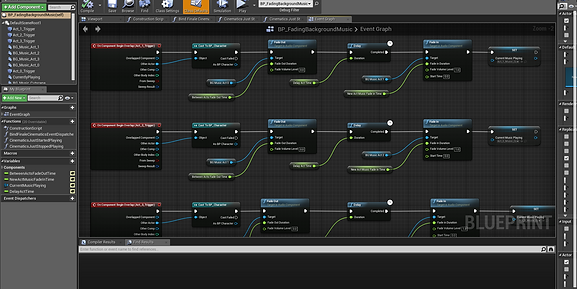
Blueprint to control background music
My game designer specified that the music should change along with the mood of the game and fade smoothly from level to level. I developed a system that worked using triggers placed in the world to change the background music being played. This system meant that if the game designer changed her mind about where the music should change, it was a simple matter of moving the trigger.
For ease of use, I also made each piece of music to be played a variable. This meant that as our composers delivered new music I was easily able to switch out pieces and versions.
I used the Sound Cue editor to create randomness in environmental sounds like insect chatter and birdsong. The randomness helped the world feel more alive and also alleviated some frustration players reported when they heard the insect sounds being repeated over and over again.
I chose to use Sound Cues rather than Blueprints to create this randomness because of the ease with which I could add effects like reverb, pitch modulation, and volume multipliers. I also found that testing individual sounds was far simpler in the Sound Cue editor than Blueprint.
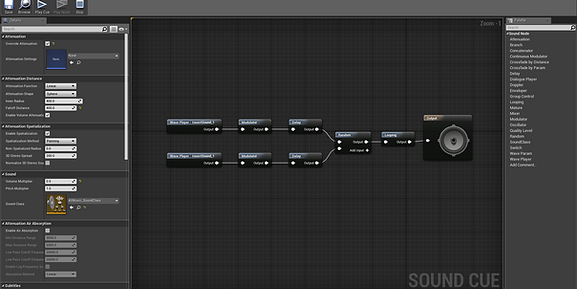
A sound cue that randomly chooses between two insect sounds every x seconds
Acoustic Environments
As the only sound designer on my team, I was responsible for creating all of the acoustic environments in La Rana. I worked closely with my game designer to make sure I was upholding the game's vision during the process of gathering the sound effects and balancing the sound.
I was also responsible for working with both composers whose work is featured in La Rana. I gave them feedback and direction to iterate on their music and regularly sent them gameplay footage so they could see how their music fit into the game's world.
To experience the acoustic environments for yourself, please follow the download link at the top of the page to download La Rana for free from Steam. The videos below also highlight some of my audio work.
La Rana features a lot of water, both environmentally and as a gameplay mechanic. When I began searching for sound effects and designing acoustic environments I knew water would be key. I wanted to make sure the player could orient themselves towards the nearest water source using the audio as their guide.
I foleyed the "refill station" sound effect using a bamboo water fountain and edited it using Audacity to give it a pleasant echo. The result is a soothing sound that the player can follow to find the nearest refill station.
One of La Rana's most appealing aspects is its visuals. The artists and designers on my team worked very hard to create stunning and lifelike environments. As sound designer, I wanted to do my part to "flesh out" these environments with interesting sounds.
In response to suggestions from several members of my team, I added birdsong in parts of the levels that had open ceilings. I also added insect sounds to many of the bushes to help create a jungle-like atmosphere.
Gameplay sounds are critical to help with conveyance and player experience. While balancing the sound in La Rana I prioritized gameplay sounds over anything else. I rationalized that the player should always be able to hear the character squirt water, jump, and die, and that puzzle elements like moving blocks and lily pads should be clearly audible over the background music.
Balancing sounds and music was a unique challenge. I worked with my team's game designer during the beta milestones to make sure the sounds and sound balance fit with the game's vision and tone.
Additional Screenshots
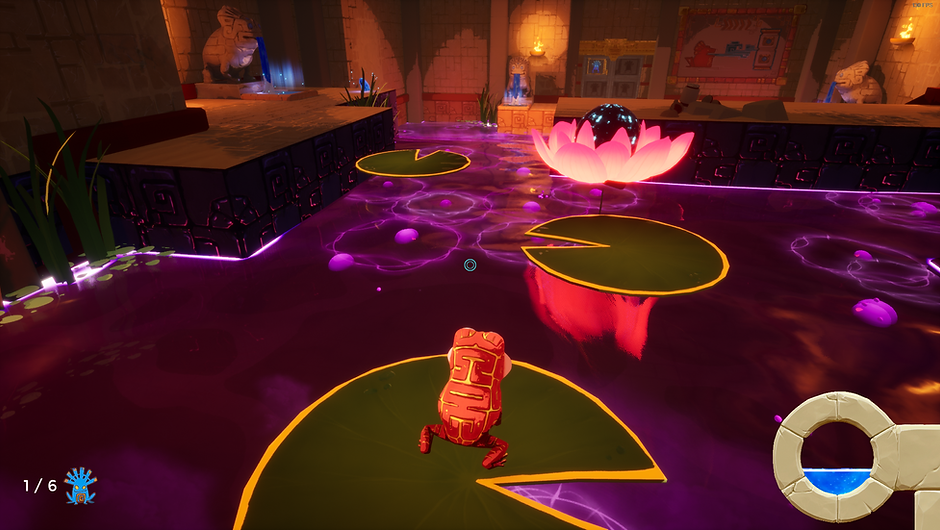


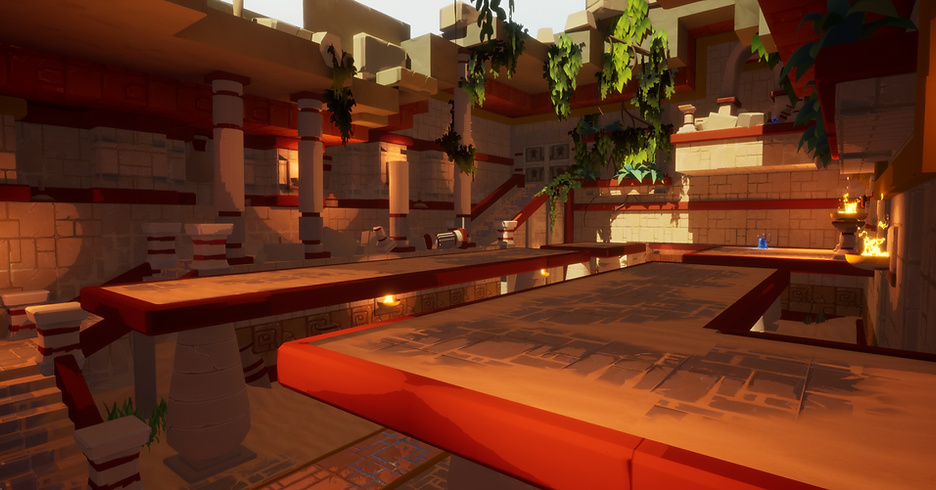




Project Post Mortem
What Went Well
-
Overall, communication and workflow on my team was unproblematic. Many team members collaborated well across disciplines and demonstrated respectful cooperation in meetings and during work time.
-
The team stuck to our core design ideas and pillars throughout development. We set out to create a simple, fun, visually appealing game and succeeded in doing so through many hours of hard work.
-
The game was released on Steam!
-
I was able to communicate well with different leads, our stakeholders, and our producer throughout the project to make sure the needs of my one-man sound team were being met.
-
Iterations entering the alpha and beta milestones were targeted and focused so our team avoided wasting time.
What Went Wrong
-
Towards the beginning of the project, the team struggled a bit to adjust to new leads and ideas.
-
I did not personally keep up with much documentation regarding sound. This became a problem during the beta milestone when I was asked to gather provenance information for many of the sound effects and had to dig through my Google Chrome history to remember where I had found some of them.
-
The project was wildly overscoped at the start. At the end of the alpha milestone we were forced to cut an entire level in favor of aesthetics. This meant that the gameplay experience was dramatically shortened.
-
The game's vision and target audience changed a lot during development, which made it difficult to keep up-to-date on the game designer's desires for the project.
What I Learned
-
I learned a lot about sound! When I started the project, I knew next to nothing about sound design or development. Now I have practice balancing and creating sounds.
-
I learned that communication is as much about listening as talking. I learned that active listening and notetaking are the best ways to make sure I am on the same page as everyone else.
-
I learned that sometimes the best way to handle a problem is to let someone more qualified take the front seat. Early in the project I tried to do a great deal of Blueprinting on my own and found I was backed into a corner, but when I allowed software developers to help the process went much more smoothly.
-
I learned that clear, concise daily goals are essential to accomplishing any task efficiently. My team practiced excellent Agile habits like daily scrum meetings, and our producer managed our team's workflow and daily goals very well.
